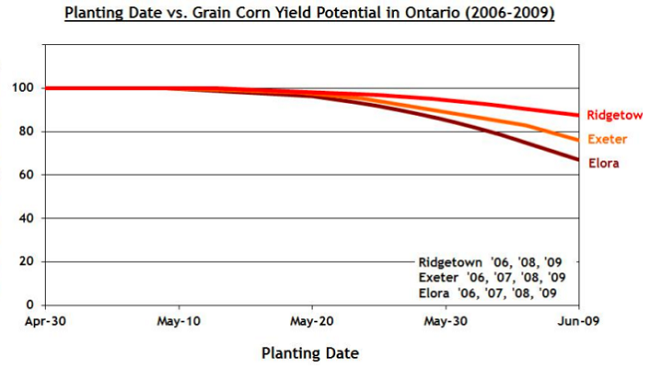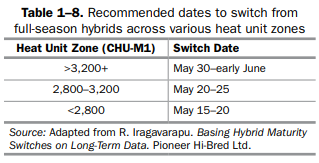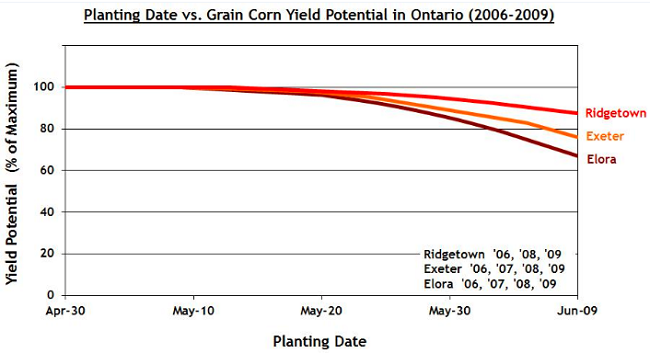
Breakfast Sponsor: Thanks, from the group, to Bob Thirwall, Bayer Crop Science / Dekalb Seeds
Synopsis: Field work remains limited due to frequent and heavy rainfall. Wheat remains a concern with a high number of Agricorp damage reports in the region. Nitrogen applications on wheat are variable depending on soil conditions. Reports of a few corn and soybean fields planted on sand soils at the beginning of the week, but planting is yet to start for most growers. From a planting date perspective, yield potential for corn and soybeans remains high, and switching to lower maturity hybrids is not recommended until towards the end of May in the Southwest. Patience and morale remain good.
Winter Wheat: Reports from London area suggest wheat planted September or early October is at Zadok’s 30 to 31 (first node just beginning to emerge). Some report flag leaves emerging in very early September planted wheat in Essex County. Nitrogen applications vary with soil conditions. Drier areas such as Midwestern Ontario are estimated to have applied N on 75-80% of the crop that is being kept, with a large amount applied in the last couple days. Areas remaining wet have applied little. Some growers unable to get on fields are considering applying a small amount (30 lb-N/ac) by aircraft, while others have been using partial tank loads or flotation tires. Ontario research suggests yield loss for applying no nitrogen by flag leaf stage is 15%.
There have been questions about crop injury with nitrogen and herbicide applications. No Ontario data is available but applying both at the same time increases risk for injury. Group discussion suggests waiting at least 1-3 days between applications to avoid injury and speculated that applying nitrogen before herbicide may increase injury as UAN has been shown to solubilize leaf cuticle, which given weather conditions this spring may already be thin.
Discussion and further explanation around maximum residue limits (MRL’s) for exports pertaining to Manipulator growth regulator use in wheat has shown to have all necessary approvals for export. All grain companies in Ontario are accepting deliveries. For further information, please contact Bill Norman from Belchim Crop Protection at 226-378-4328.
Year to date total number of winter wheat damage reports as a percentage of total winter wheat endorsements for Essex County, Chatham-Kent and Lambton County are approximately 70%. Chatham-Kent has the greatest number of Damage Reports followed by Lambton County followed by Essex County. On a total acres damaged to date basis, this year’s damaged acres are 342% of 2018’s total damaged winter wheat acres. It is important to note that damage reports do not equate to claims. Please refer to www.agricorp.com for news and updates to what your winter wheat insurance covers such as reseeding, USAB (unseeded acreage benefit) and production claims.
For wheat being removed, general estimates are 75% would be planted to soybeans and 25% would be planted to corn. As the calendar date progress, these portions are expected to tilt towards soybeans, though corn prices have been competitive relative to soybeans.
Soybeans: Reports that a field or two of soybeans have been planted on sand soils the beginning of this week, but in general soybean planting is yet to start.
Cool, wet conditions at planting can be concern for early season seedling and root rot diseases, especially on clay soils for Pythium and Phytophthora root rot. Diseases such as Fusarium root rot and Sudden Death Syndrome (SDS) will especially benefit from these conditions if June becomes dry and is followed by rain events.
In Southwestern Ontario, Soybean Cyst Nematode (SCN) reproduction on SCN soybean varieties containing the PI88788 source of SCN resistance is increasing. In fields with a significant shift to these adapted SCN populations, yields reductions of 15 to 20 bushel/ac or more have been observed. Adding soybean varieties with Peking source of SCN resistance in rotation with PI88788 varieties is necessary to slow PI88788 adapted populations from increasing in fields. Planting soybeans after soybeans, including where wheat stands will be removed, can increase the risk for the above diseases as well as others. Variety rotation is suggested.
Corn: Reports of some planting activity starting on sand soils in Delhi and Rodney areas at the beginning of the week, but overall almost no corn has been planted. When thinking about weed control, growers are reminded that dicamba should not be applied ahead of corn.
While moods are reported to still be good, with delays in planting and rain in the forecast there has been discussion around dates for switching to shorter season hybrids. Growers who were planning on planting very long season corn for their area have returned seed, but those with adapted hybrids in the Southwest are suggested to maintain their selections until the end of the month.
Suggested switch dates from Pub 811: Agronomy Guide for Field Crops is presented in Table 1. These switch dates are adapted from US data and represent dates where shorter season hybrids started to result in greater returns after drying costs and test weight deductions relative to full season hybrids. Maturities should be reduced 100 CHU every week after. It is important to note these switch dates are for hybrid maturities adapted for these areas. If you intend to plant hybrids with longer maturities, you should switch hybrids earlier. If drying costs are more concerning to you, you may want to switch on the earlier side of suggested dates.
Table 1. Recommended dates to switch from full-season hybrids across various heat unit zones (Pub 811, Agronomy Guide for field Crops).

While some are concerned that we are now into May and little corn has been planted, it is important to note that the planting window for high yield potential is still open. Ontario data suggests 95% yield potential is still attainable if corn is planted by May 20 at Elora, May 25 in Exeter and June 1 in Ridgetown (Figure 1). This assumes corn is planted into suitable soil conditions. If one feels pressured to push planting into marginal soil conditions in attempts of an earlier planting date to maximize yields, the yield loss risk of planting into unfit soil should be weighed against the expected yield loss of delaying planting. The above data suggests that during the first half of May, yield losses due to delaying planting may be relatively small.
Later corn planting can delay silking dates which can increase ear mould risks if conditions later in the growing season are suitable for ear mould infection and development. Discussion around AAFC researcher Dr. Ting Zhou who has discovered enzymes from soil bacteria which can convert deoxynivalenol (DON) mycotoxins to a non-toxic form. This has been shown to work in the lab, but there is still work needed to show if these can work in field or industrial operations.

Figure 1. Average corn yield response to planting date at three locations in Ontario from 2006-2009. Yield is average of eight adapted hybrids selected for each location (Dave Hooker and Greg Stewart).
Edible Beans: No edible bean planting reported. Contracts are reported to still be available for most market classes. Hensall District Co-op is looking for a co-operator for dry bean variety plots in Essex county. For more information contact Wade Bickell at wbickell@hdc.on.ca.
Horticulture Crops: Sugarbeet planting is estimated to be 30% complete. Stands of early planted sugar beets are reported to be reasonable. Some other hort crops (carrots) have started to be planted again the beginning of this week. First scheduled planting date for tomatoes is May 9, assuming fields are fit. With labour availability concerns at planting, there is increased interest in robotic transplanters. Other early hort crops such as peas remain to be planted.
Forage Crops: While forage crops are benefitting from frequent precipitation this spring, reports of winter kill is higher than what is typically observed. Losses of alfalfa and even grasses is especially apparent where water or ice accumulation over winter lead to oxygen starvation, but also apparent where other compounding stresses such as manure tanker compaction from fall applications was present. Damage does not necessarily appear to be related to stand age. Alfalfa weevil are reported to have started showing up.
Next Meeting: Ridgetown Agribusiness meetings are held in the Willson Hall Campus Centre (downstairs) at the University of Guelph Ridgetown Campus. Meetings start at 7:15 am with breakfast and every two weeks on Tuesdays. One continuing education unit (CEU) is available at each meeting for Certified Crop Advisers. Next meeting is May 21, 2019.
Source : Field Crop News